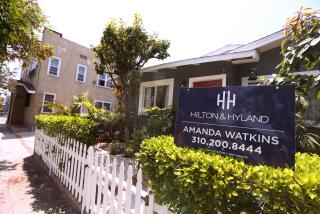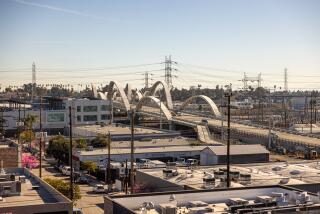Festival Turns Spotlight on Progress of Noho Arts District
Poised to celebrate its sixth year, the NoHo Arts District festival is expected to draw more than 30,000 visitors this weekend to revel in its accomplishments and promise.
Many business leaders and community officials say the area is well on its way to becoming a theater-driven district worthy of the catchy NoHo tag--a play on the avant-garde SoHo section of New York City.
Other area business owners, however, say the pace of redevelopment is too slow, and that they are suffering the ill effects of ongoing subway construction.
The area was christened the “NoHo Theater and Arts District” in September 1992, at the first meeting of a special cultural committee formed under the auspices of the Universal City/North Hollywood Chamber of Commerce.
“The NoHo Arts District was a chance for unity,” said Walter Beaumont, an assistant project manager for the city’s Community Redevelopment Agency in North Hollywood. “With the arts district, we are trying to take an area that had a bad reputation--somewhat deserved--and make it better.”
The annual NoHo Theatre & Arts Festival will be held today and Sunday from noon to 8 p.m.
When the CRA began redevelopment in North Hollywood in 1979, the project had an assessed value of $290 million. Now the assessed value is just below $700 million, Beaumont said. In the year ending June 30, 1997, the CRA received about $5 million in tax revenue and spent about $3.5 million, approximately $800,000 of that on the arts district.
That figure for NoHo will drop slightly this year, mostly because tax revenues that CRA expects to collect have not caught up with the improving economy, Beaumont said.
But not enough has been done to justify using money that could help other city programs, said Glenn Hoiby, a representative on the Project Area Committee and the owner of a commercial property in NoHo.
“People are afraid to attack the idea of an arts district,” he said. “Seeing how much has been spent and how little has been accomplished in the 19 years [the CRA has] been here is really disappointing.”
The area now called NoHo has its symbolic center at the intersection at Magnolia and Lankershim boulevards and expands outward roughly to Cahuenga Boulevard on the east, Tujunga Avenue on the west, Hatteras Street on the north and Camarillo Street on the south.
In 1979, the Los Angeles City Council established its first redevelopment project in the Valley in North Hollywood. The CRA currently oversees redevelopment on about 750 acres in North Hollywood, with about 50 acres comprising the NoHo Arts District, Beaumont said.
As community-improvement efforts gained momentum in the late ‘80s and early ‘90s, many of the entertainment-industry residents began to turn their energies toward invigorating the local artistic ventures.
In the early ‘90s, the Academy of Television Arts and Sciences built a large complex on Lankershim, and an old Department of Water and Power building was turned into the city-financed Lankershim Arts Center. NoHo became home to numerous video, recording and dance studios.
In 1992, the Universal City/North Hollywood Chamber of Commerce joined with the Valley Theater League in renaming the area.
From only a handful of theaters when the ‘90s began, the area now has more than 20 theaters. And people are watching. According to organizers of “Chaim’s Love Song” at the Bitter Truth Theatre, the play sold out on weekends from Feb. 21 to the end of May.
“I wanted to see it become the best theater district in the country and I think it’s well on the way,” said David A. Cox, vice president and artistic director of the American Renegade Theater Co. and a vice president of the Chamber of Commerce. “It’s been a tremendous change. When we first came here there were stores galore--anywhere and everywhere--and only two theaters. One by one they [theaters] started coming.”
But the effort to revitalize NoHo has had setbacks.
The 1994 Northridge earthquake shook the community’s dreams as well as damaged some of its more prominent structures.
The historic El Portal, run by the nonprofit group Actors Alley, was less than a month from opening when the quake wiped out its $250,000 CRA-funded renovation.
The damage was so extensive that a $1.3-million grant from the Federal Emergency Management Agency in 1996 didn’t cover the damage. Earlier this year, FEMA agreed to give another $3.8 million for the theater’s restoration. Only now, after more than four years of seeking funds and restoring the 72-year-old theater, is Actors Alley making plans to reopen early next year.
The American Renegade Theatre on Magnolia was condemned and torn down and a new theater was built on Lankershim. Plans call for a September opening.
According to representatives at the Chamber of Commerce, the quake forced dozens of businesses to close temporarily. But the arts district survived.
“During the earthquake everybody pulled together and unified,” said Stanley Brent, president of the nonprofit North Hollywood Community Forum. “Everybody decided that it was worth seeing through the bad times.”
An ongoing problem for NoHo businesses is the construction of the North Hollywood portion of the Metro Red Line subway, scheduled to be completed in May 2000 and to run from Universal City to a station at the corner of Lankershim and Chandler boulevards.
“Businesses are definitely impacted by our construction projects,” said Mark Pattison, assistant manager for public affairs for the North Hollywood project. “If you can make it through this, once our station opens there will definitely be an increase in business traffic.” MTA officials estimated that up to 200,000 people will use the NoHo station every day.
But some of the area’s small business owners say they can’t survive until the subway is complete.
Craig Klapman, owner of Sam’s Book City on Lankershim, said business has declined so much since the MTA started construction that he will have to permanently close next month.
“There has been a bookstore at this location for 26 years,” said Klapman, who has owned the store since 1992.
Citing a revenue decline of more than 50% since 1994, Klapman said the construction has torn up the area so much that some customers can’t even find his store and others just don’t want to come to the area.
“It’s like a cursed area,” he said. “I really wanted this bookstore to survive beyond me. It’s a great loss to the community.”
James Albright, owner of Haunted Studios III and Gilberts Costumes, said his business is so bad because of MTA construction that he can’t afford to pay rent. Albright’s studio is on land owned by the MTA. He pays the agency $4,445 a month and owes more than $60,000 in back rent.
“It’s a frustration artistically and a frustration business-wise,” he said. “I don’t see why I should have to pay full rent to the MTA, when they are the ones who are causing me to lose so much money.”
Albright moved into his NoHo location after the Northridge earthquake destroyed his building in Hollywood. In 1996, Albright won the Valley Economic Development Center’s Phoenix Award for his perseverance in the face of the earthquake.
Now, Albright can’t understand why nobody is willing to help him. “I thought the commendation meant something,” he said. “I always assumed I would have help from somebody when I needed it.”
MTA officials cautioned about blaming them for the trouble some businesses are facing.
“It’s hard for us to ascertain how much of their business problems is because of us,” Pattison said. “A lot of the businesses out there may be struggling, but they’re struggling without us having construction in front of them.”
The MTA has given between $200,000 and $300,000 for advertising to businesses in the district every year since construction began in 1995, Pattison said. Additionally, the MTA has paid $690,000 in liability settlements to businesses around the Lankershim tunneling project, MTA spokesman Gary Wosk said.
Pointing to the positives, such as the success of Ned’s Cafe, the Eclectic Cafe, Pit Fire Pizza Co. and the many theaters, supporters of development say the future is bright.
A Starbucks is slated to start construction on the southeast corner of Lankershim and Magnolia and other large projects are up for consideration.
One is a 42-acre site surrounding the MTA station that would include entertainment studios, offices, retail and a hotel, Beaumont said. He declined to name the company that has proposed the project, saying it is too early in the process.
Most of the business owners in the arts district say they are willing to wait it out in hopes of better times.
“I’ve been through earthquakes, I’ve been through MTA construction and I’ve been through just about everything bad in this neighborhood that could happen,” said Star Irvine, owner of Eagles Newsstand Cafe, a coffee and sandwich shop located within a block of the planned Starbucks.
“My only complaint is that all the development needs to be faster,” she said. “Let’s just do it.”
More to Read
The biggest entertainment stories
Get our big stories about Hollywood, film, television, music, arts, culture and more right in your inbox as soon as they publish.
You may occasionally receive promotional content from the Los Angeles Times.










